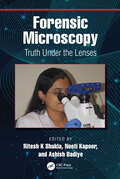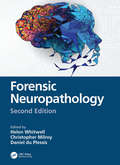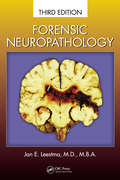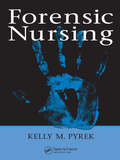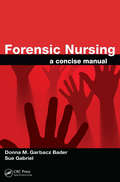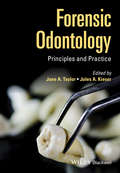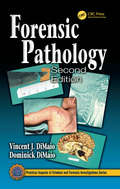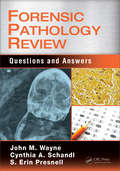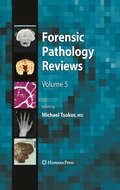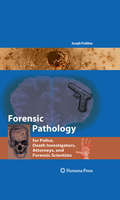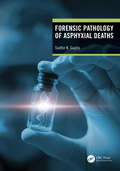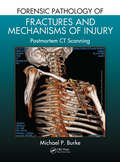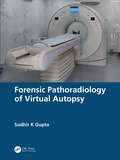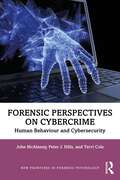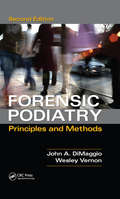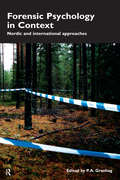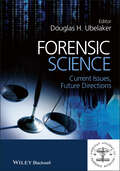- Table View
- List View
Forensic Microscopy: Truth Under the Lenses
by Ritesh K. Shukla Neeti Kapoor Ashish BadiyeForensic Microscopy: Truth Under the Lenses provides an overview and understanding of the various types of microscopes and their techniques employed in forensic science. The book emphasizes both the theoretical and practical aspects of microscopy to enrich the reader’s understanding of the various tools, techniques, and utility—including strengths and weaknesses—of types of microscopes in analyzing certain forms of evidence. The book begins with the history of microscopes, the basic optics for microscopy, then moves to advanced microscopies such as electron microscopes and atomic force microscopes. In addition to the various types of microscopes and how to use and best utilize them, the book looks at the analysis of specific types of evidence, including hair, fiber, fingerprint, body fluids, tool marks, ink, pollen grains, spores, diatoms, bullets, cartridges, among other evidence types. Since forensic science is an applied, hands-on discipline, the book includes both a theoretical and a practical approach to the topic. Key Features: • Addresses simple to advanced microscopy techniques for the effective analyses of trace evidence • Pairs chapters on a particular type of microscopy, explaining it thoroughly, before delving into specific usage for forensic applications • Presents theories and as well as real-world application of concepts • Provides abundant micro-photographs, including graphical representations and flow charts, to illustrate concepts clearly Forensic Microscopy serves as a helpful reference for undergraduate and postgraduate students in forensic science, forensic biology, forensic chemistry and related programs. It is also recommended for research students, academicians, technicians, industry and laboratory professionals working on trace evidence analysis.
Forensic Neuropathology
by Helen Whitwell Christopher Milroy Daniel Du PlessisForensic neuropathology is an important specialty within forensic pathology. In addition to traumatic brain injury in the adult and child, forensic neuropathologists must also consider the role of natural disease within the forensic setting such as cerebrovascular disease, as well as neurotoxicology. Focusing on difficulties that arise in the medico-legal context, the chapters include techniques for the post-mortem examination of the brain and related structures. Forensic pathologists, neuropathologists, general pathologists, clinical forensic specialists as well as neuroscientists, neurologists and neurosurgeons will all find useful information. In addition, members of the legal profession have found this an important reference work. Chapters have been extensively revised and new content includes - Chronic traumatic encephalopathy-related pathology - Sudden unexplained death in epilepsy - Biomechanics of head injury - Updates on pathological aspects of head injury including infant head injury with ocular pathology - Clinical aspects of head injury and spinal injury including a new chapter on neuroradiology Reviews of the First Edition This outstanding book is unique. Well-illustrated with high-quality colour photographs and line drawings, it reads well. Strongly recommended for trainees in histopathology, neuropathology, paediatric pathology, and forensic pathology, as well as for consultants practising in these fields.
Forensic Neuropathology
by Jan E. LeestmaThe field of forensic neuropathology covers such controversial topics as the effects of repeated brain trauma in football players and how babies probably cannot die from being shaken. Jan Leestma is one of the most respected voices in this area. A timely update to his classic reference, Forensic Neuropathology: Third Edition presents an encyclopedi
Forensic Nursing
by Kelly M. PyrekWritten by an award-winning investigative journalist with more than twenty years of experience, Forensic Nursing takes an objective yet engaging look at a profession that according to the author, "is only for those with a strong stomach, a pure heart, and a quick mind." It presents the personal experiences and perspectives of forensic nurses that w
Forensic Nursing: A Concise Manual
by Donna M. Garbacz Bader Sue GabrielThe forensic nurse has a powerful role in medical-legal investigations. Going beyond the nurse‘s traditional role, forensic nurses are often at the forefront of evidence collection and preservation. They can maintain an evidentiary chain of custody, testify as an expert witness in a court of law, care for victims, assist victims families, and work
Forensic Odontology
by Sam Evans Romina Carabott Catherine AdamsAn accessible, essential introduction to forensic odontology. Written by a team of well-established, active practitioners in the field, Forensic Odontology is invaluable for those needing an introduction to the subject for the general dental practitioner who has an interest in forensic dentistry and is contemplating practicing in the field. It will also be useful as a reference during practice. After a brief introduction the book covers dental anatomy and development, expert witness skills, mortuary practice, dental human identification, disaster victim identification, dental age assessment, bite marks, forensic photography and the role of the forensic odontologist in protection of the vulnerable person. Chapters outline accepted and recommended practices and refer to particular methodologies, presenting different schools of thought objectively.
Forensic Odontology
by Jules Kieser Jane TaylorForensic odontology refers to the science and practice of dentistry which may be applied to help solve litigation in both criminal and civil cases. It is a specialist branch of dentistry that assists the legal system in the handling, analysis and interpretation of dental evidence.Forensic Odontology: Principles and Practice pulls together the very latest research findings and advice on best practice and essential skills, including aspects of forensic science that provide a well-rounded educational experience for the reader. Chapters provide coverage of anatomy and morphology, mortuary techniques, physical anthropology, applied forensic sciences, child and elder abuse, and facial approximation. The text introduces the various topics and discusses underpinning philosophies without being an exhaustive historical treatise. Appropriate case studies are used to highlight issues, and references to current research are provided to stimulate further reading and research.Written by experienced practitioners in the field, this informative introductory text is invaluable to graduate and undergraduate students, as well as experienced dentists, wishing to gain experience or pursue a career in forensic odontology. This text will be a welcome addition to the forensic odontological libraries of all practicing forensic odontologists.
Forensic Pathology
by Myron H. Dembo Helena Seli Vincent J.M. DiMaio M.D. Dominick DiMaioMedicolegal investigation of death is the most crucial and significant function of the medical examiner within the criminal justice system. The medical examiner is primarily concerned with violent, sudden, unexpected, and suspicious deaths and is responsible for determining the cause and manner of death, identifying the deceased, determining the ap
Forensic Pathology Review: Questions and Answers
by Md John Wayne Cynthia Schandl S. PresnellThis book is an invaluable tool for studying and reviewing key concepts in forensic pathology. Written in a question-and-answer format, this accessible guide tests readers' knowledge of manner of death, patterns of injury, lab data interpretation, postmortem radiography and imaging, and much more. Over 300 questions, more than half with visual examples, cover both common and more unusual examples of forensic pathology seen in practice. A great resource for preparing for examinations including the American Board of Pathology examination. It provides answers with explanatory rationales for both correct and incorrect answers.
Forensic Pathology Reviews
by Elisabeth E. TurkFresh research has opened up new vistas in forensic pathology that are allowing for closer national and international cooperation between pathologists and scientists in a range of medical and scientific disciplines. At the same time, autopsy and laboratory techniques are undergoing rapid evolution, with new procedures coming on stream while existing processes yield additional--and more accurate--results. This sixth volume of reviews in forensic pathology provides professionals working in the field with cutting-edge material on the latest key advances in the fields of traumatic death, sudden natural death and death time estimation. Now with numerous color illustrations, the book gives forensic experts across the world a fully up-to-date guide to contemporary procedures and theory in forensic science and medicine. The chapters cover an exhaustive range of aspects in the discipline, from the analysis of sudden natural deaths in infancy and childhood to the cardiac proteomics approach in the study of cases involving sudden cardiac death. Other specialist chapters deal with the forensic investigation of deaths in aviation and as a result of accidents involving all-terrain vehicles. The volume covers fresh research in the use of protein markers for the estimation of post-mortem intervals, and features a chapter telling the story of the medico-legal investigation into the deaths resulting from the 9-11 terrorist attacks on the World Trade Center. Comprehensive and current, this fresh volume of reviews is an essential resource for professionals who need to stay ahead of the game in a fast-moving and exciting field of scientific endeavor.
Forensic Pathology Reviews 5
by Michael TsokosIn this new volume of the globally recognized Forensic Pathology Reviews, Dr. Michael Tsokos has gathered chapters from the top experts in the field to reveal both the applied and scientific areas of expertise along the broad spectrum of forensics studies. Volume 5 piques the mind as leading forensic pathologists from the United States and around the world offer advanced insight into death caused environmental conditions, trauma, neuropathology, natural causes, and ballistics. The authors of this volume further their exploration as they impart research related to identification, serial murder, histopathology, and age estimation. While unveiling unsurpassed and cutting-edge knowledge, Forensic Pathology Reviews, Volume 5 will also inspire emerging forensic scientists to immerse themselves in innovative research.
Forensic Pathology for Police, Death Investigators, Attorneys, and Forensic Scientists
by Joseph A. PrahlowForensic Pathology for Police, Death Investigators, Attorneys, and Forensic Scientists is a forensic pathology book specifically written for professionals who interact with forensic pathologists. The book includes sections that address various general topics which are not normally present in the typical forensic pathology text, such as descriptions of medical, pathology and forensic pathology training, basic anatomy and physiology, an overview of other forensic science disciplines, and autopsy performance. Forensic Pathology for Police, Death Investigators, Attorneys, and Forensic Scientists also covers classic topics in forensic pathology, including death investigation, death certification, postmortem changes, and the entire range of case types, ranging from natural deaths to drug-related deaths to various types of violent death. The text is written in easy-to-understand language, and is complemented by hundreds of high-quality photographs.
Forensic Pathology of Asphyxial Deaths
by Sudhir K GuptaThis book provides an overview of Asphyxial Deaths which includes hanging, strangulation, choking, smothering, gagging, drowning, aspiration, mechanical and chemical asphyxiants, etc. Postmortem examination often leads to doubts as a clear distinction between the different type of asphyxia cannot be made easily. Forensic and physiological aspects are discussed with the help of illustrative cases. The author discusses the different aspects of asphyxia deaths and substantiates multiple case studies to establish a scientific approach that can act as a guideline to the autopsy surgeon in providing a precise opinion and clarify doubts for the judiciary involved in such criminal justice cases. Key Features• Presents individual case studies of Asphyxial deaths. • Covers the guidelines to be followed by the autopsy surgeons in different cases.• Discusses the physiological aspects of Asphyxial deaths in detail.• Illustrates the cases in a stepwise manner with more than 350 colored photographs of postmortem examination.
Forensic Pathology of Fractures and Mechanisms of Injury: Postmortem CT Scanning
by Michael P. BurkePractitioners of forensic medicine have various tools at their disposal to determine cause of death, and today‘s computed tomography (CT) can provide valuable clues if images are interpreted properly. This volume is a guide for the forensic pathologist who wants to use CT imaging to assist in determining the mechanism of injury that might have contributed to death. Enhanced with hundreds of CT images that clarify the text and case studies to put the material in context, the book gives a head-to-toe catalogue of various injuries and how they are represented on a CT scan.
Forensic Pathology of Infancy and Childhood
by Roger W. Byard Kim A. CollinsThe investigation of sudden or unexplained death of children represents a unique medical and forensic area of study. Children have unique anatomic and functional characteristics that must be recognized and understood by the medical investigator. Further complicating this process is the fact that the anatomic structure, composition and function of various organs and organ systems in the pediatric population change throughout the developmental stages of childhood. The disease processes, reactions to trauma and risk factors for accidental death and homicide change from infancy through adolescence. "Forensic Pathology of Infancy and Childhood" provides an authoritative, comprehensive reference text devoted to the medicolegal investigation of sudden unexpected death in children. With contributions from internationally renowned experts, individual chapters focus on specific unique causes and organ systems with detailed accounts of the changes in fatal diseases, risk factors of causes of sudden death, and responses to fatal trauma that occur as a child grows from neonatal stage through infancy, toddlerhood, childhood and adolescence. This text is an essential reference resource for forensic pathologists, medical examiner offices, pediatric pathologists, pediatric hospitals, anatomic pathologists and those in training as well as those in related legal professions. "
Forensic Pathoradiology of Virtual Autopsy
by Sudhir K GuptaVirtual autopsy is a burgeoning field that employs imaging methods to find the cause of death. This book critically analyses and compares different post-mortem features and their radiological appearance in diverse cases. It orients the forensic doctors trained in traditional autopsy to understand the radiological appearance of their gross findings and the radiologists to comprehend the pathology in an imaging study. Further, it provides the standard operating protocols to be followed in different cases. This can be an alternative to standard autopsies for broad and systemic examination of the whole body as it saves time, aids better diagnosis, and respects religious sentiments. Key features: Provides the reader with an in-depth review of the value of a CT-directed virtual autopsy complementing a regular autopsy and how it can enhance the quality of medico-legal death investigation in a jurisdiction. Bridges the gap between the specialities of Forensic Medicine and Radiology and helps the readers co-relate and understand the concept of Virtual Autopsy. Features over 500 original autopsy photographs and CT images with over 100 case reports including a stepwise approach to each case along with comparative radiological images.
Forensic Perspectives on Cybercrime: Human Behaviour and Cybersecurity (New Frontiers in Forensic Psychology)
by Peter J. Hills Terri Cole John McAlaneyForensic Perspectives on Cybercrime is the first book to combine the disciplines of cyberpsychology and forensic psychology, helping to define this emergent area. It explores the psychological factors that influence the behaviour of all those involved in cybersecurity, drawing upon the research literatures in relevant areas including forensic, social, and cyberpsychology.Written by leading figures in the field, the book provides an introduction to the cybercrime ecosystem, before discussing the psychological manipulation of targets through social engineering techniques and highlighting the unique threats that this type of attack presents. The reasons why people become involved in hacking are explored, and the authors review research literature on risk factors of being a victim of cybercrime, along with the concept of resilience. Behaviour change and prevention strategies are also evaluated, as well as the role of emergent technologies such as artificial intelligence and what this may mean for the role of humans in cybersecurity. Case studies and real-world examples are woven throughout to illustrate key issues, opportunities, and challenges.This unique text is a must-read for students undertaking any degree that relates to behaviour and cybersecurity, including psychology, computing, law, and business management. It is also highly relevant to researchers, practitioners, and policymakers who work in cybersecurity and/or have an interest in empowering people to be safe online.
Forensic Photography
by Nick MarshForensic photography plays a vitally important part in the investigation of crime and the subsequent administration of justice. Written by a practitioner with many years professional experience, this book provides an overview of the most common forensic photography techniques in use today for those readers who may not have a detailed understanding of camera techniques and who need to get to grips with the use of light and other key scientific aspects of the job. It covers image capture issues, file handling and relevant equipment, such as lasers and UV lights, and explores how they work. The predominance of the digital camera has resulted in an increasing trend for police forces across the world to use untrained camera users, rather than expert photographers. Therefore, this book will prove invaluable for those practitioners who need to produce accurate and clear photographic evidence, above and beyond the point and shoot mode on their cameras.
Forensic Podiatry
by John A. Dimaggio Wesley Vernon ObeThe human foot is a complex body part composed of fifty-two bones, which is twenty-five percent of all the bones in the body. Nonetheless, the foot is often viewed by the public and doctors as a "minor" body part. Similarly, the importance of pedal evidence in crime investigation has also long been undervalued, but as footwear evidence has become more commonly used in forensic situations, so has pedal evidence, which is why this seminal work is so important: it is the first textbook ever dedicated to forensic podiatry. Forensic Podiatry is an international compilation of current practices authored by the pioneers in the field. Part I discusses general forensic concerns, including those at the crime scene, from an informative perspective. It covers tasks performed by the crime laboratory, forensic podiatry principles, and various aspects of human identification. Part II deals with specific forensic podiatric concerns such as photographic techniques, bare footprint identification, and footwear examination and analysis. It also discusses forensic gate and analysis as well as the identification of pedal remains from podiatry records, which is important for mass disaster scenes. Part III presents actual forensic podiatry case studies from the United Kingdom and the United States, and Part IV focuses on podiatry practice standards, which in many instances parallel expert witness responsibilities. Groundbreaking and essential, this book is useful for medical and criminal justice students as well as podiatrists, criminalists, footwear examiners, forensic anthropologists, attorneys and investigators.
Forensic Podiatry: Principles and Methods, Second Edition
by Denis Wesley Vernon John A. DiMaggioForensic Podiatry: Principles and Methods, Second Edition has been completely updated to reflect the latest developments and advancements in this changing field. New additions to the book, from the previous edition, include all new chapters on the expert witness, Frye Test, and Daubert Standard, as well as revised theories on gait analysis, bare footprint identification, and footwear examination. The new edition includes extensive case studies and an international compilation of current best practices. Since this text’s first publication, the field of forensic podiatry has rapidly developed from relative obscurity to a dynamic, internationally recognized discipline. Forensic podiatrists have been able to advance improvements in the field, both in widening the range of applications and deepening the practice through improved techniques to strengthen evidentiary conclusions. Written by two pioneers in the field, Forensic Podiatry includes over one hundred detailed illustrations to serve as an invaluable resource for students, practicing forensic podiatrists, legal professionals and those new to the profession.
Forensic Psychiatry: Clinical, Legal and Ethical Issues, Second Edition
by John Gunn Ian D. Hutcheon Pamela TaylorHighly Commended, BMA Medical Book Awards 2014Comprehensive and erudite, Forensic Psychiatry: Clinical, Legal and Ethical Issues, Second Edition is a practical guide to the psychiatry of offenders, victims, and survivors of crime. This landmark publication has been completely updated but retains all the features that made the first edition such a w
Forensic Psychology
by Solomon M. Fulero Lawrence S. WrightsmanWritten by two of the leading authorities in the field, FORENSIC PSYCHOLOGY, Third Edition introduces you to the practice of forensic psychology by showing how psychologists aid the legal system by serving as expert witnesses, criminal profilers, and trial consultants for jury selection and child custody hearings. Wrightsman and Fulero present the roles and responsibilities of forensic psychologists, and address both the opportunities and temptations inherent in those roles. Through this lens, the authors explore the ethical issues facing practicing forensic psychologists, such as promising clients too much, the possibility of becoming advocates rather than objective scientists, and the pitfalls associated with substituting one's values for data. The authors provide an accurate and candid picture of the field, and the range of careers in forensic psychology.
Forensic Psychology in Context: Nordic and International Approaches
by P. A. GranhagAcademics and researchers from the Nordic countries (Sweden, Iceland, Norway, Finland) have made a particularly strong contribution internationally to the rapidly developing disciplines of forensic and legal psychology. This book brings together the leading authorities in the field to look systematically at the central issues and concerns of their subject, looking at both investigative psychology and psychology in court. Forensic Psychology in Context reflects the results of research in the Nordic countries themselves, but each chapter situates this work within a broader comparative and international context. The book is a major contribution to the subject, and will be essential reading for anybody with interests in this field.
Forensic Psychology: Concepts, Debates and Practice
by Joanna R. Adler Jacqueline M GrayThis book brings together academics, practitioners and experts in the field of forensic psychology to demonstrate the scope of the discipline and push its parameters. Its aim is to go beyond introductory texts to challenge perceptions, to raise questions for research and to pose problems for practice. The editors hope to inspire and stimulate debate about how forensic psychology can aid the practice of justice. The book is divided into six sections, addressing key topics from the discipline: investigation and prosecution; testimony and evidence; serious and persistent offending; treatment as intervention; intervention and prevention and punishment and corrections. The contributors are drawn from the UK, the USA and Australia.This updated, revised and significantly expanded edition develops the picture of diversity and depth of forensic psychology; considers ways in which the discipline has progressed and identifies challenges for its future sustainability and growth. includes a new section on treatment as intervention with contributions on personality disordered offenders; anger control group work with forensic psychiatric inpatients; and developments in treatment for drug misuse offenders additional chapters throughout including contributions on UK police interviews; the investigation and prosecutoin of rape; the effect of gender in the courtroom; forensic psychology and terrorism; the aetiology of genocide; self harm in prisons; post-corrections reintegration and many more an innovative textbook on forensic psychology exploring application of the subject and setting forensic psychology in a broader context demonstrates ways in which forensic psychology can aid the practice of criminal justice This book will be essential reading for students of forensic psychology and practitioners working in the field.
Forensic Science
by Douglas H. UbelakerCo-published with the American Academy of Forensic Sciences, Forensic Science presents comprehensive international discussion of key issues and future directions within the forensic sciences. Written by accomplished and respected specialists in approximately eleven distinct areas of the forensic sciences, the volume will examine central issues within each discipline, provide perspective on current debate and explore current and proposed research initiatives. It will also provide the forensically involved international community with current in-depth perspective on the key issues in the contemporary practice of the forensic sciences.
